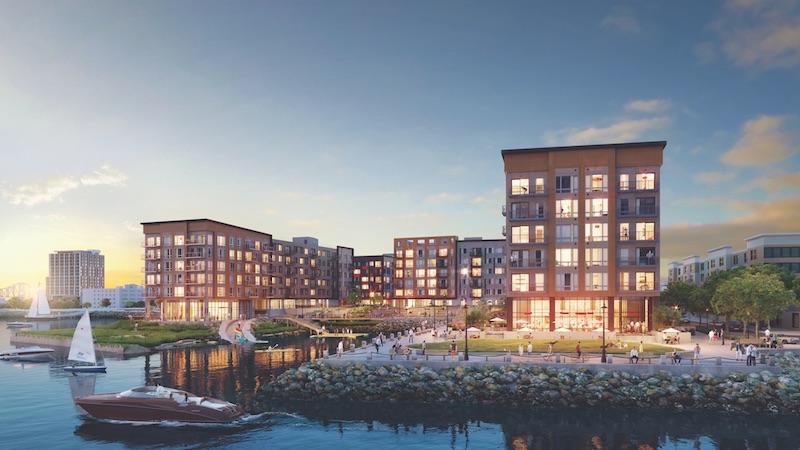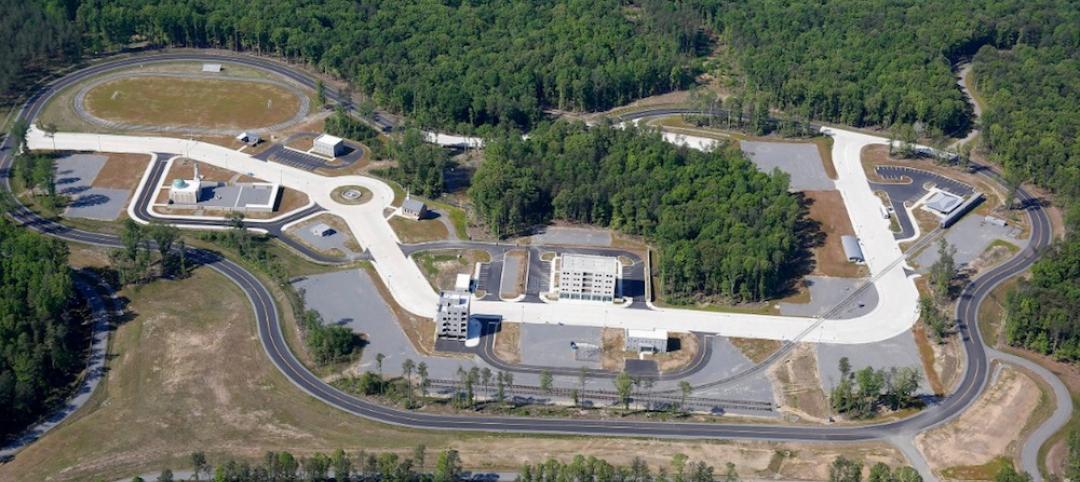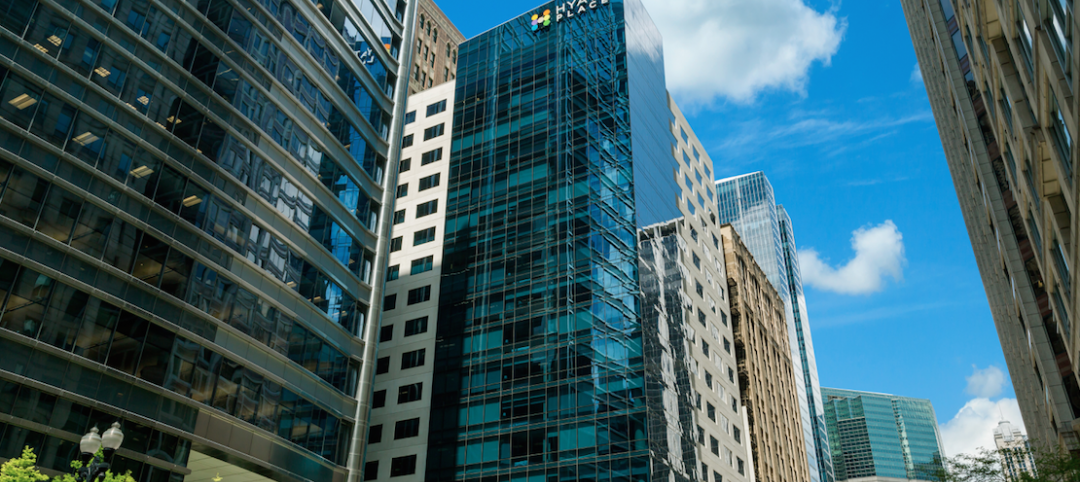Houston is America’s fourth-largest city, thanks in part to its embrace of unfettered growth. But its swagger got doused during the last week of August, when Hurricane Harvey dropped more than 50 inches of rain, bringing a drenched and debilitated southeast Texas to its knees.
While the wreckage from the storm in Texas and Louisiana was still being assessed in mid-September, preliminary estimates suggest that Harvey could turn out to be the costliest natural disaster in U.S. history: $150 billion to $180 billion in damage, according to Texas Governor Greg Abbott. The latest estimates put the death toll over 70, with more than 100,000 structures damaged or destroyed, and 440,000 residents and businesses applying for aid from the Federal Emergency Management Agency (FEMA).
Harvey’s wrath raises questions, once again, about the wisdom and sanity of building and rebuilding in areas vulnerable to severe weather and seismic events. Arriving a decade after Hurricane Katrina and five years after Superstorm Sandy,
Harvey also raised the question, What is it going to take for cities, states, and the federal government to finally get serious about resilience in their funding, planning, development, and construction?
“Each event that comes along elevates resilience in the eyes of the public about the need to be prepared, and to design communities to provide survivable conditions,” says Alex Wilson, President of the Resilient Design Institute.
Are today’s resilient solutions up to that kind of extreme challenge? Experts have debated the effectiveness of resilient best practices for decades. But what’s altered the discussion lately has been the frequency and destructiveness of severe weather and seismic events. Houston has had 500-year floods in each of the past three years. On September 7, Mexico was rocked by an 8.2-magnitude earthquake, the strongest to rattle that country in a century.
“The cost of rebuilding is driving demand for climate change resilience design,” says Kim Pexton, LEED Fellow and Director with Paladino and Company, the sustainability and green building consultant. “The federal government has paid for rebuilding after natural disasters at a rate that is not financially sustainable.”
Pexton notes that FEMA—which before Harvey hit had only $3.3 billion in its disaster relief fund and was facing budget cuts—doles out disaster recovery money only to those states that have resilience plans in place.
Unlike energy efficiency and sustainability, climate change is not something cities can opt out of, says Janice Barnes, PhD, LEED AP BD+C, Principal and Global Resilience Director with Perkins +Will. Metros that include New York, Boston, San Francisco, Seattle, and New Orleans have moved resilience to their front burners for planning and redevelopment.
In Florida, where “sunny day” flooding is becoming alarmingly common in some coastal markets, Palm Beach County this summer created its first Office of Resilience to combat the effects of climate change. Miami residents will vote in November on a $400 million bond issue, of which $192 million would specifically address sea-level rising and flooding.
“America and its governing bodies have woken up to vulnerability, and resilience has become front and center. That’s a huge shift,” says Illya Azaroff, Director of Design with +LAB Architect, who co-authored AIA’s 2017 Disaster Relief Handbook and wrote a 44-page post-Sandy Initiatives report.
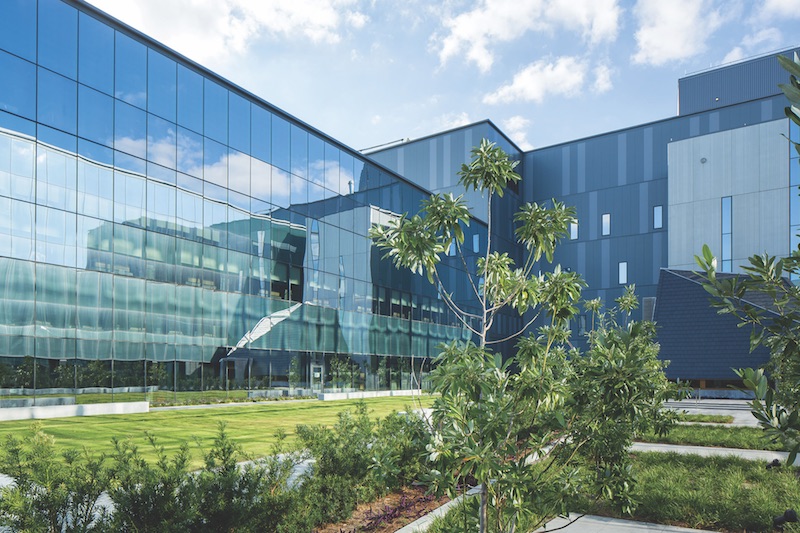 The 1.6 million-sf Southeast Louisiana Veterans Health Care System Replacement Medical Center in New Orleans can withstand Category 3-level storms. It is distinguished by an outdoor ramp that, in the event of flooding, boats can use to reach the emergency department on the second floor. Photo: NBBJ.
The 1.6 million-sf Southeast Louisiana Veterans Health Care System Replacement Medical Center in New Orleans can withstand Category 3-level storms. It is distinguished by an outdoor ramp that, in the event of flooding, boats can use to reach the emergency department on the second floor. Photo: NBBJ.
Some cities and towns are even contemplating the politically fraught option of relocating people outside of floodplains that are expanding due to rising tides (see sidebar on page 50).
“Maybe it’s time to start letting nature help us instead of fighting it, and to figure out how to be in balance again,” says Steve McDowell, FAIA, LEED AP, President, CEO, and Design Director of BNIM, whose portfolio includes helping redesign and rebuild the town of Greensburg, Kan., which lost 950 of its 1,000 structures to an EF-5 tornado in 2007.
BNIM and Lake | Flato Architects were wrapping up work on their renovation of the 12,727-sf Sunset Coffee Building and outdoor plaza, which sits atop Houston’s Buffalo Bayou, when Harvey blew in and flooded that building’s lowest floor.
That floor is programmed for rentable canoes, kayaks, and bikes, knowing that floodwaters will envelop the space. Water never penetrated the street-level floor, which continued to operate with full HVAC and electrical service post-storm. The Building Team used materials on the ground floor that could withstand flooding—concrete masonry wall units, galvanized and stainless steel, perforated roll-up doors, and concrete floors—and mitigate climatic exposures and conditions, such as mold, rot, and damage from wind or projectiles.
The flood damage will require lower-level repairs to its fire-alarm system, elevator, and other electrical systems, says Bob Harris, FAIA, LEED Fellow, Partner with Lake | Flato. Despite that, “the building appears to have held up well, given what it went through,” adds Casey Cassius, LEED AP, Principal with BNIM.
WHY RESILIENCE?
With all this climatic turmoil, Paladino’s Pexton contends that any objections to resilience are simply “rooted in short-term thinking and outmoded assumptions.” But what, exactly, is resilience?
The American Society of Civil Engineers defines it as “the ability to suffer less damage and recover more quickly from adverse events,” including external shocks like floods but also economic, social, political, or cultural stressors that disrupt a community.
At the very least, says Wilson, buildings in flood-prone areas should be able to maintain their habitability after being hit by a storm so they can continue to serve as shelters.
The problem is that resilience in Chicago or Charlotte isn’t necessarily what’s needed in Portland, Ore., or Phoenix. As a concept, resilience is much like wellness in that it’s difficult to quantify its results in ways that lure investors or premium tenants. Where benefits from energy efficiency and sustainability are almost immediately measurable, the impact of resilience is often evaluated in terms of years, even decades.
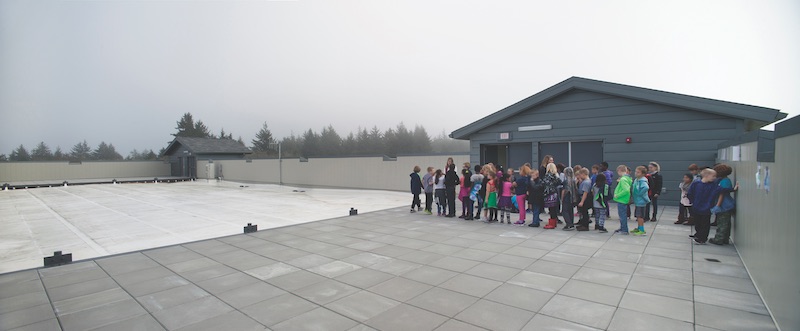 The roof of Ocosta Elementary School in Westport, Wash., serves as a vertical tsunami and earthquake refuge, 53 feet above sea level. The building, which opened in the fall of 2016, is anchored by 169 pilings sunk 50 feet deep or more. Its resilience premium was $2 million of the school’s $16 million project cost. Photo: Pete Eckert/eckert photography.
The roof of Ocosta Elementary School in Westport, Wash., serves as a vertical tsunami and earthquake refuge, 53 feet above sea level. The building, which opened in the fall of 2016, is anchored by 169 pilings sunk 50 feet deep or more. Its resilience premium was $2 million of the school’s $16 million project cost. Photo: Pete Eckert/eckert photography.
“Anyone who is looking short term at a project or development probably isn’t thinking about resilience,” says Barnes. But too many people, businesses, and cities only think about resilience after the latest disaster. “It is an events-based reality, not a day-to-day thing,” says Colin Koop, AIA, Design Director in Skidmore, Owings & Merrill’s New York office. “A lot of clients are being told to worry about resilience, but they don’t understand how it applies to their buildings.”
With new guidelines and standards emerging from multiple sources (see related article, page 42), this discipline opens opportunities for AEC firms to be what Koop calls “first responders” to help direct projects toward resilient solutions, and to explain the intrinsic value of resilience to investors and end users.
“What we’re talking about here is creating a new vocabulary for consumers,” says Barnes.
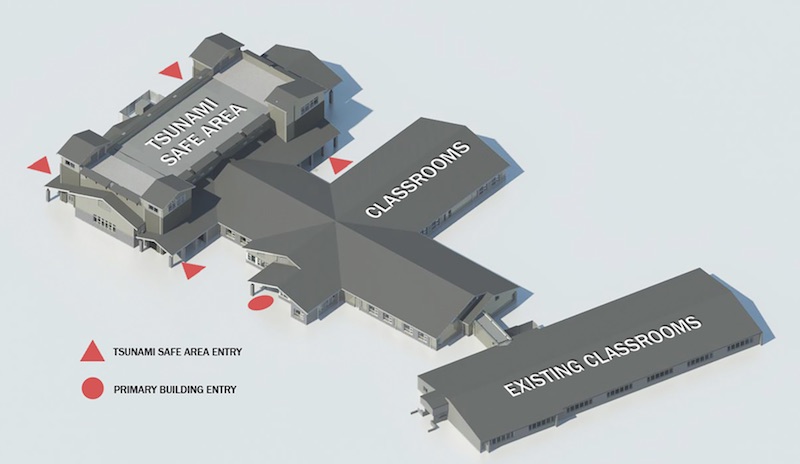
FLOODWATERS WITH no place to go place millions of americans at risk
Rising sea levels could be the biggest long-term threat to cities. A recent study by researchers at the University of Georgia and Stetson University estimates that a six-foot rise in sea levels would place 13.1 million Americans living along the coasts at risk. Even a three-foot rise—well within the latest projections by climatologists—would endanger four million people.
“Low-lying waterfront communities are growing,” warns Edgar Westerhof, National Director of Flood Risk and Resilience with Arcadis North America. If, as expected, global urbanization advances unabated mostly near coastal areas, the battle for survival, adaptation, and growth “will be won or lost in the field of resilience,” his firm states.
One of Arcadis’s recent resilience projects was a three-year contract with the Nassau County (N.Y.) Department of Public Works to stabilize, design, and rebuild the county’s wastewater collection and treatment systems, which were severely damaged during Sandy. That $2 billion project, which Arcadis and partner Hazen and Sawyer completed last year, included applying extreme weather-hardening techniques to mitigate the impacts of future storms on five treatment plants and more than 30 pump stations.
Houston has been battling wet conditions since it was founded in 1830. Its system of channelized bayous that runs through the city has been no match for the severe weather the metro and its surrounding suburbs have endured over the past 15 years.
As a prerequisite to receiving $66.6 million in community block grants from HUD after two major flood events in 2015, Houston finally published a 74-page action plan for disaster recovery.
But overdevelopment and weak zoning are seen as an impediment to any mitigation strategy for this sprawling metropolis of 6.5 million people, which spreads over nine counties. Some 30% of Harris County, which includes the city, is pavement, and Houston gained 24% more pavement between 1996 and 2011. The Houston–Galveston Bay metroplex has lost 65 square miles of freshwater wetlands since 1953. Meanwhile, dams that support Houston’s bayous are “extremely high risk,” according to the Army Corps of Engineers, which had completed only 10% of a $75 million dam-repair project when Harvey descended.
Houston is hardly alone among U.S. cities in choosing development over risk management. Westerhof recalls that, before Sandy, New York City “didn’t have a clue” about its key assets and vulnerabilities. Azaroff adds that, despite public awareness of the threats, most people “still don’t recognize what it’s going to take” to protect cities and buildings from impending natural disasters.
FXFOWLE’s clients often don’t know where resilience starts and ends, and are "looking for guidance,” says Ilana Judah, AIA, LEED AP, OAQ, CPHD, Principal and Director of Sustainability. “First of all, there has to be some clarity about what measures to take. Is there an area of refuge in the building? Has the owner created a common area with showers, emergency power, etc.?”
BEST PRACTICES EMERGE
As a growing number of cities and developers seek ways to mitigate damage from natural disasters, AEC firms are playing advisory roles.
Last June, the Alexandria (Va.) City Council approved a plan to turn 206 acres within that city’s Old Town North neighborhood into an eco-district. In its sustainability analysis for that plan, SmithGroupJJR identified 17 acres that could be impacted by sea level rise. “It’s important to understand the future state and have that overlay" for discussions about development, says Greg Mella, FAIA, LEED AP BD+C, SmithGroupJJR’s Director of Sustainable Design.
“It all starts with site analysis,” says Jennifer Cooper-Sabo, LEED AP, Landscape Practice Lead and Senior Associate with Perkins+Will in San Francisco. Her firm now asks three questions about every project: What are the climate change projections for the area? What are the vulnerabilities and consequences of those projections? How can design mitigate those vulnerabilities?
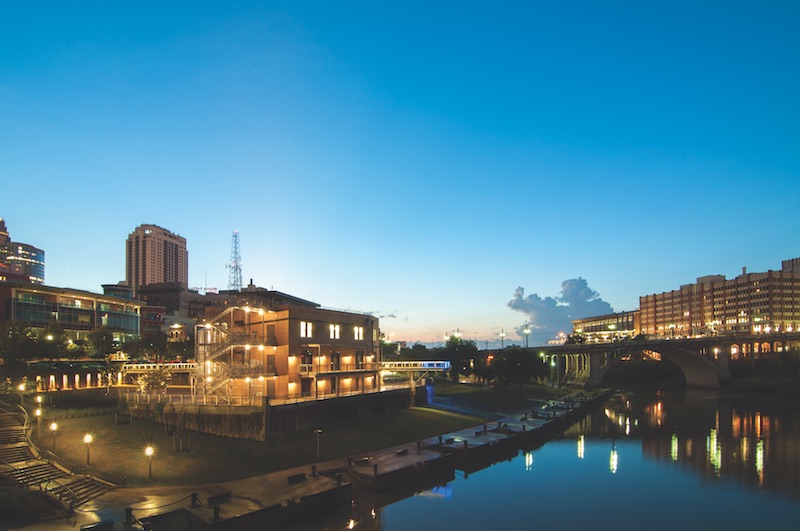 The extensive renovation of the 12,727-sf Sunset Coffee Building in Houston took Hurricane Harvey’s battering and lived to tell about it. The ground floor, which will house rental bikes and boats, is programmed and built to be floodable, and incurred relatively minor damage. Photo: Luis Ayala, courtesy Lake|Flato Architects.
The extensive renovation of the 12,727-sf Sunset Coffee Building in Houston took Hurricane Harvey’s battering and lived to tell about it. The ground floor, which will house rental bikes and boats, is programmed and built to be floodable, and incurred relatively minor damage. Photo: Luis Ayala, courtesy Lake|Flato Architects.
In a recent paper he authored for the American Society for Healthcare Engineering, Richard Weber, Principal with Wiss, Janney, Elstner Associates, presents a case study of how a building could have avoided the considerable damage it suffered from an EF-1 tornado by: 1) using higher-strength glass to prevent window penetration from wind, rain, and projectiles; 2) securing the roof perimeter with such measures as peel-stop bars; 3) installing concrete instead of metal ducts; and 4) using stiffer backer board behind cladding.
Resilient design is sometimes positioned as a companion to adaptive design, which allows a structure to be built with the understanding that its design assumptions might change, and also to passive design, which allows a building to function with modest utilities support.
Judah calls these concepts “designing for unpredictability,” and says that if buildings can be kept resilient and comfortable more passively, “we are at the intersection of adaptation and mitigation.”
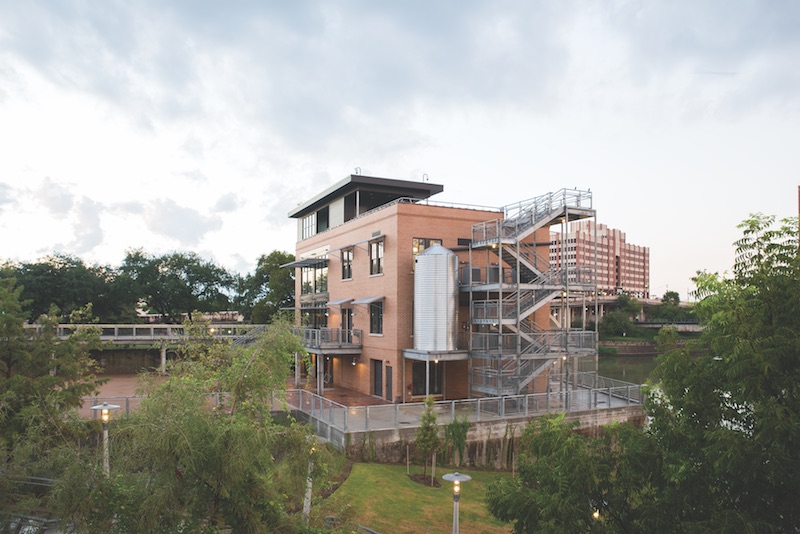 Floodwaters never entered the street-level floors of the Sunset Cofee Building, whose mechanicals and electrical system remained operable. Photo: Luis Ayala, courtesy Lake|Flato Architects.
Floodwaters never entered the street-level floors of the Sunset Cofee Building, whose mechanicals and electrical system remained operable. Photo: Luis Ayala, courtesy Lake|Flato Architects.
MORE PROJECTS INCORPORATE RESILIENCE MEASURES
Next year, the first phase of the 10-mile-long Lower Manhattan Coastal Resiliency Project, known as The Dryline, is scheduled to break ground. Other ambitious projects that incorporate resilience are either just completed or in the works (see related story, page 38). These include Water Street Tampa, a 50-acre, $3 billion mixed-use community that, over the next decade, will be built at least 11 feet above current sea level. Many of its 18 buildings and nine million sf of
retail, residential, office, and entertainment space will be 15 to 25 feet above sea level, according to Bryan Moll, Executive Vice President and Director of Development with Strategic Property Partners, the project’s developer.
The 181 Fremont Tower project, a 56-story, $665 million office/apartment high-rise in San Francisco due to open in phases starting in December, claims to be the most earthquake-resilient building in the western United States. Heller Manus Architects designed the building to achieve a Gold rating from the Resilience-based Earthquake Design Initiative (REDi), devised by Arup, the project’s structural and geotechnical engineer.
Viscous dampers integrated into 181 Fremont’s steel megabraces and uplifting megacolumns reduce the potential for earthquake damage. Its caissons burrow 260 feet below ground and are anchored into bedrock. A REDi Gold building can expect its repair costs after a quake to be a fraction of code-designed buildings, and its downtime to be weeks instead of months.
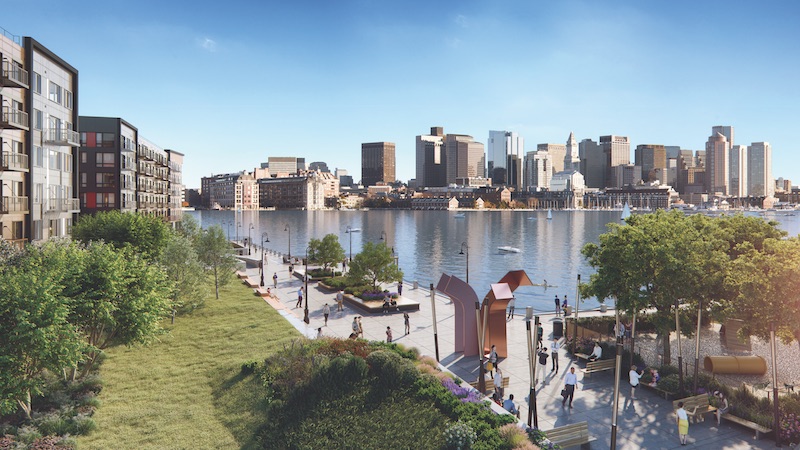 For its Clippership Wharf development in Boston, Lendlease is converting one of the piers to a “living shoreline” by creating a series of terraces for new salt marshes and a habitat for Boston Harbor, which is subject to a 10-foot tidal influence. The first floor of each building will be 24 feet above Boston City Base. All infrastructure and mechanical systems will be located above the 100-year flood level. Garage levels will be flood resistant. Courtesy Lendlease Development.
For its Clippership Wharf development in Boston, Lendlease is converting one of the piers to a “living shoreline” by creating a series of terraces for new salt marshes and a habitat for Boston Harbor, which is subject to a 10-foot tidal influence. The first floor of each building will be 24 feet above Boston City Base. All infrastructure and mechanical systems will be located above the 100-year flood level. Garage levels will be flood resistant. Courtesy Lendlease Development.
Two signature resiliency projects that AEC experts singled out are the Spaulding Rehabilitation Hospital Boston, which opened in 2013, and the Southeast Louisiana Veterans Health Care System Replacement Medical Center in New Orleans, which started accepting patients last December.
Perkins+Will was working on the 262,000-sf, 132-bed Spaulding Rehab project when Hurricane Katrina hit New Orleans. That storm prevented hospitals from evacuating patients, some of whom died from heat exposure. So P+W designed Spaulding with operable windows on all floors. Mechanical systems were moved to penthouse areas. The primary diesel storage in the basement is housed in a flood-proof vault with a 150,000-gallon tank. Extensive granite berms were installed to deflect flooding from Boston Harbor and Little Mystic River. And the first floor of the building—which can be flooded without disrupting the hospital’s occupancies or operations—is 30 inches above the 500-year flood elevation.
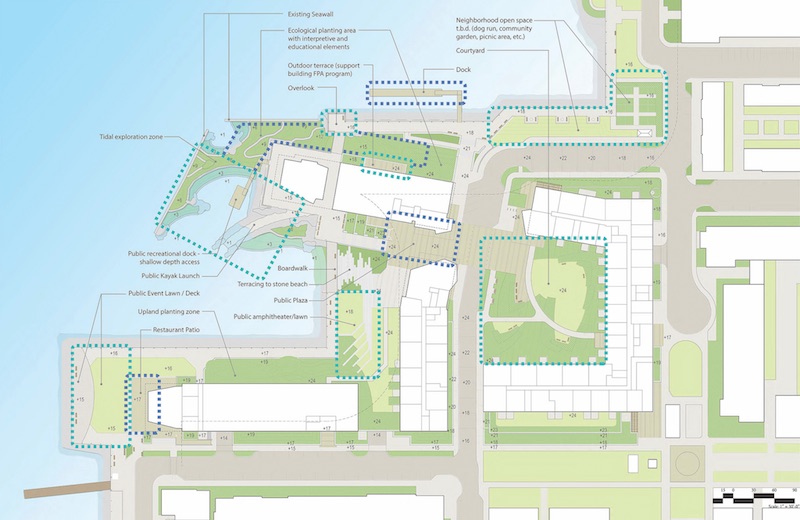 Courtesy Lendlease Development.
Courtesy Lendlease Development.
Resilience measures accounted for only $1.5 million of Spaulding’s $160 million construction cost, and half of that premium paid for encasing a high-voltage electrical riser through the building.
After Katrina destroyed its medical center in New Orleans, the Department of Veterans Affairs replaced the facility with a four-story, 1.6 million-sf complex whose perimeter can withstand Category 3 storms, and whose walls are hardened to resist blasts, ballistic assaults, and ramming. The hospital’s second-floor emergency department is accessible via an outdoor ramp that can accommodate boats in the event of severe flooding. NBBJ designed the replacement medical center with Eskew+Dumez+Ripple and Rozas Ward. A joint venture between McCarthy Building Cos. and Clark Construction built it.
MAYORS TAKING THE LEAD
Speakers at the recent 2017 Resilient Cities Summit in Stowe, Vt., envisioned a future where cities “reimagine” themselves to protect their physical and human assets against more frequent and intense natural disasters.
Making that happen will require more and better community outreach and engagement, as well as collaboration with private industry. The speakers urged that resilience be viewed as a catalyst for solving numerous additional problems, such as the shortage of affordable housing.
“Where we’re still failing is in social resilience,” says Kristen Hall, LEED AP, Senior Urban Designer with Perkins+Will in San Francisco. Hence, Beaumont, Texas, running out of water after Harvey, and the islands of St. John and St. Maarten running out of food after Irma.
The country “isn’t at the resilience finish line yet,” agrees Rachel Minnery, FAIA, LEED AP, Senior Director of Sustainable Development Policy with the American Institute of Architects. She points out that 30% of America’s cities and towns aren’t covered by, or choose to opt out of, resilience-related building codes.
The AIA is among 43 trade groups that have signed on with the Resilience Building Coalition to promote resilience in planning, building materials, design, construction, and operational techniques. The AIA and the BuildStrong Coalition—a resilience advocacy group of first responders, architects, builders, engineers, insurers, and manufacturers—support a disaster deductible bill proposed by Rep. Mario Rafael Díaz-Balart Caballero (R-Fla.) which, if passed and funded, would incentivize construction that’s built to resilience codes.
It’s tough, though, to get elected officials to appropriate money to prepare for unpredictable events, says Josh Sawislak, Global Director of Resilience with AECOM, who helped write the Obama Administration’s executive order on flood-risk management. This fact is doubly true today, with climate change deniers running the federal government. Ten days before Harvey hit, President Trump rescinded a 2015 executive order requiring any design proposals for public infrastructure in flood-prone areas to include sea level projections.
While FEMA and HUD will continue to be starting points for state and urban disaster relief, “Washington has no interest in managing this issue,” contends Fiona Cousins, PE, LEED AP BD+C, Principal and Director with Arup in New York. She says she believes mayors and the private sector will be the resilience champions for the foreseeable future.
 A walkway around the periphery of Roosevelt Island in New York’s East River will serve as the first line of resilient defense for Cornell Tech, an applied science campus for Cornell University and Technion Israel Institute of Technology. The 12.9-acre campus will expand to 2 million sf over the next 25 years. Photo: Iwan Baan.
A walkway around the periphery of Roosevelt Island in New York’s East River will serve as the first line of resilient defense for Cornell Tech, an applied science campus for Cornell University and Technion Israel Institute of Technology. The 12.9-acre campus will expand to 2 million sf over the next 25 years. Photo: Iwan Baan.
WILL INVESTORS VALUE RESILIENCE?
Some investors naturally want to know if resilience translates into increased property value. But just as natural disasters are unpredictable, so, too, is the ROI of resilience.
The benefits seem clearest for cities. A National Institute of Building Sciences study estimates that every dollar spent on disaster mitigation could save $4 in response and recovery costs. Resilient cities “will be the ones drawing investment and development,” predicted John Macomber, a professor at Harvard Business School, who spoke at the Resilient Cities Summit.
Resilience design experts anticipate that cities will turn to public-private partnerships to finance resilience projects that can be large-scale and costly. Cities like Philadelphia have encouraged private investment to fund stormwater management systems, says Katharine Burgess, AICP, Senior Director of Urban Resilience with the Urban Land Institute.
The Resilient Design Institute’s Wilson thinks that resilience has the potential to follow the same path as LEED, which “took off” once investors saw that certified buildings had cachet with renters and buyers. “Even Donald Trump bragged about his LEED buildings,” he quips.
Businesses and investors need to figure out what resilience means to them, and why it’s important. “We’re not there yet,” says +LAB's Azaroff. But that day could be fast approaching. AIA’s Minnery says she’s already keeping an eye on credit ratings of cities to track whether the more resilient metros are getting bumps.
After Superstorm Sandy, New York City’s Metropolitan Transit Authority issued several series of bonds designated as “Climate Bond Certified.” AECOM's Sawislak says financial markets are starting to put a price on climate risk. “That’s going to create different ways of looking at business, development, and investment.” He also points out that reinsurers like Swiss Re have been looking at offering “parametric insurance” policies that cover risk using triggers like rainfall, wind velocity, and earthquakes.
Arcadis’s Westerhof notes that cities like Copenhagen and Rotterdam have combined resilience with economic growth. “That’s where we need to be in the U.S.,” says Westerhof. “Then resilience becomes a matter of urban rejuvenation.”
Related Stories
| Sep 26, 2016
BD+C's GreenZone structure en route to Greenbuild in Los Angeles
The 2016 Compton YouthBuild Education Center gets set for a ride from Porland, Ore., to Los Angeles, where the 600-sf structure will be on display at Greenbuild 2016 (Oct 5-6).
| Sep 9, 2016
Going to Greenbuild/LA? Be a BD+C 'Special Correspondent'
Building Design+Construction is looking for a few special Greenbuild 2016 attendees to join our team of Special Correspondents who are reporting all the news from Greenbuild-Los Angeles.
Greenbuild Report | Dec 23, 2015
How engineers help developers meet green building objectives
Engineers say AEC teams need to be on the same page to help clients realize goals that often boil down to minimizing construction and operating costs.
Greenbuild Report | Dec 14, 2015
Sensible sustainability: The new standard for hotels
In October 2008, The Proximity, a 147-room hotel in Greensboro, N.C., became the first LEED Platinum–certified hotel in the U.S. Since then, only two other hotels have earned LEED Platinum.
Greenbuild Report | Dec 10, 2015
AASHE’s STARS tool highlights the university sector’s holistic approach to sustainability
Buzzwords like “living lab” and “experiential learning” are indicative of the trend toward more holistic sustainability programs that incorporate all facets of college life.


